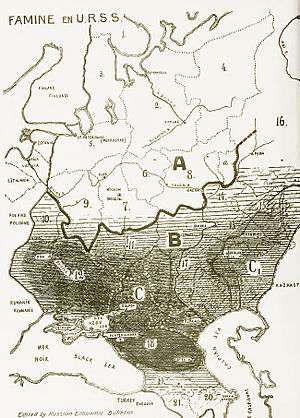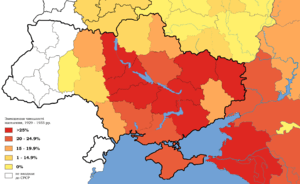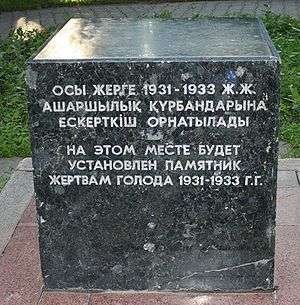Soviet famine of 1932–33


The Soviet famine of 1932–33 affected the major grain-producing areas of the Soviet Union, leading to millions of deaths in those areas and severe food shortage throughout the USSR. These areas included Ukraine, Northern Caucasus, Volga Region and Kazakhstan,[2] the South Urals, and West Siberia.[3][4] Gareth Jones was the first western journalist to report the inhumane devastation.[5][6][lower-alpha 1] The subset of the famine within the Ukrainian Soviet Socialist Republic, the Kuban, is called Holodomor, all of which were heavily populated by Ukrainians.
The famine was the result of the actions of the Soviet state in the implementation of forced collectivization, in economic planning, and political repression in the countryside.
Reasons
Unlike the previous famine of 1921–22, Russia's intermittent drought was not severe in the affected areas at this time.[7]
The government's forced collectivization of agriculture, a part of the Soviet Union's first five-year plan, forced grain procurement, and political repression in the countryside were the main reasons for the famine.
Historian Mark B. Tauger of West Virginia University suggests that the famine was caused by a combination of factors, specifically low harvest due to natural disasters combined with increased demand for food caused by the collectivization, industrialization and urbanization, and grain exports by the Soviet Union at the same time.[8]
A similar view was presented by Stephen Wheatcroft, who has given more weight to the "ill-conceived policies" of Soviet government and highlighted that while the policy was not targeted at Ukraine specifically, it was Ukraine who suffered most for "demographic reasons".[9]
The Law of Spikelets
For those who stayed in the countryside, often the only place where any food could be found was on collective farms, but the peasants were forbidden to eat their own crops. The "Decree About the Protection of Socialist Property" – nicknamed by the farmers the Law of Spikelets – was enacted on August 7, 1932. Under the Decree, political police and party officials were allowed to confiscate unlimited amounts of grain from peasant households. Thus, taking food – even a handful of rotting grain or produce – was considered theft of "socialist property."
Passports

There was a wave of migration due to starvation, although authorities responded by introducing a requirement that passports be used to go between republics, and banning travel by rail.
Soviet internal passports (identity cards) were introduced on 27 December 1932 to deal with the mass exodus of peasants from the countryside. Individuals not having such a document could not leave their homes on pain of administrative penalties, such as internment in Gulag labor camps. The rural population had no right to freely keep passports and thus could not leave their villages without approval. The power to issue passports rested with the head of the kolkhoz, and identity documents were kept by the administration of the collective farms. This measure stayed in place until 1974.
The lack of passports could not completely stop peasants' leaving the countryside, but only a small percentage of those who illegally infiltrated into cities could improve their lot. Unable to find work or possibly buy or beg a little bread, farmers died in the streets of Kharkiv, Kiev, Dnipropetrovsk, Poltava, Vinnytsia, and other major cities of Ukraine.
Reactions

The famine of 1932–1933 was officially denied, so any discourse on this issue was classified as criminal "anti-Soviet propaganda" until Perestroika. The results of the 1937 census were kept secret as they revealed the demographic losses attributable to the Great Famine.
Some well known journalists, most notably Walter Duranty, downplayed the famine and its death toll.[10] In 1932, he received the Pulitzer Prize for Correspondence for his coverage of the Soviet Union's first five-year plan and thus, he was considered the most expert and savvy western journalist to cover the famine.[10] In an article "Russians Hungry, But Not Starving", he intentionally refused to mention that non-Russians were dying of the man made starvation by the millions.[11] Duranty's coverage with disinformation led directly to Franklin Roosevelt officially recognizing the Soviet Union in 1933 and thus revoked the United States' official recognition of an independent Ukraine.[12] A similar position was taken by the French Prime Minister Edouard Herriot, who toured the territory of Ukraine during his stay in the Soviet Union. However, other Western journalists did report on the famine at the time, including Malcolm Muggeridge and Gareth Jones, who both severely criticised Duranty's account and were both banned from returning to the Soviet Union.[13]
George Orwell's Animal Farm was inspired by Gareth Jones articles about the manmade Great Famine of 1932–1933.[14]
Estimation of the loss of life
- The 2004 book The Years of Hunger: Soviet Agriculture, 1931–33 by R.W. Davies and S.G. Wheatcroft, gives an estimate of 5.5 to 6.5 million deaths.[15]
- The Black Book of Communism estimates 6 million deaths in 1932–33.
- Encyclopædia Britannica estimates that 6 to 8 million people died from hunger in the Soviet Union during this period, of whom 4 to 5 million were Ukrainians.[16]
- Robert Conquest estimated at least 7 million peasants' deaths from hunger in the European part of the Soviet Union in 1932–33 (5 million in Ukraine, 1 million in the North Caucasus, and 1 million elsewhere), and an additional 1 million deaths from hunger as a result of collectivization in Kazakh ASSR.[17]
- Another study, by Michael Ellman using data given by Davies and Wheatcroft, estimates "‘about eight and a half million’ victims of famine and repression", combined, in the period 1930–33.[18]
- In his 2010 book Stalin's Genocides, Norman Naimark estimates that 3 to 5 million Ukrainians died in the famine.[19]
- In 2008 Russian state Duma issued a statement about the famine, stating that within territories of Povolzhe, Central Black Earth Region, Northern Caucasus, Ural, Crimea, Western Siberia, Kazakhstan, Ukraine and Belaruss the estimated death toll is about 7 million people.[20]
See also
- Russian famine of 1921, the first Soviet famine
- Famine in Kazakhstan of 1932–33, Kazakhstan's portion of the 1932–33 famine
- Holodomor, Ukraine portion of the 1932–33 famine
- Droughts and famines in Russia and the Soviet Union
Notes
References
- ↑ Markoff, Dr. Alexandr Pavlovich (1933). professors of the Russian Commercial Institute, eds. "Famine in the USSR" (pdf). Bulletin Economique Russe (in French). 91, Rue Lecourbe, 91; Paris 15e, France: English translation by the Russian Commercial Institute in Paris. 9. Retrieved April 18, 2016.
- ↑ Engerman, David. Modernization from the Other Shore (Google Books).
- ↑ "Famine on the South Siberia". Human Science. RU: NSC. p. 15.
- ↑ "Demographic aftermath of the famine in Kazakhstan". Weekly. RU: Demoscope. Jan 1, 2003.
- 1 2 "Welsh journalist who exposed a Soviet tragedy". walesonline.com. November 13, 2009. Retrieved April 7, 2016.
- ↑ Brown, Mark (November 12, 2009). "1930s journalist Gareth Jones to have story retold: Correspondent who exposed Soviet Ukraine's manmade famine to be focus of new documentary". The Guardian. London. Retrieved April 7, 2016.
- ↑ Viktor Kondrashin, Голод 1932—1933 годов. Трагедия российской деревни, Moscow, Росспэн, 2008, ISBN 978-5-8243-0987-4., Chapter 6. "Голод 1932—1933 годов в контексте мировых голодных бедствий и голодных лет в истории России — СССР", p. 331.
- ↑ Mark B. Tauger. "Natural Disaster and Human Actions in the Soviet Famine of 1931-1933" (PDF). Retrieved 2013-01-27.
- ↑ "The Soviet Famine of 1931-33: Politically Motivated or Ecological Disaster?". www.international.ucla.edu. Retrieved 2015-05-07.
- 1 2 Lyons, Eugene, Assignment in Utopia (Google Books).
- ↑ Walter Duranty (31 March 1933). "RUSSIANS HUNGRY, BUT NOT STARVING; Deaths From Diseases Due to Malnutrition High, Yet the Soviet Is Entrenched". The New York Times: 13. Archived from the original on 2003-03-30.
- ↑ Taylor, Sally J. (1990). Stalin's Apologist. Oxford University Press.
- ↑ Shipton, Martin (June 20, 2013). "Welsh journalist hailed one of greatest 'eyewitnesses of truth' for exposing '30s Soviet famine". Wales Online.
- ↑ Obenson, Tambay A. (July 23, 2015). "140 New Projects Selected for the IFP's 2015 Project Forum Slate". indiewire.com. Retrieved April 7, 2016.
- ↑ Davies & Wheatcroft 2004, p. 401.
- ↑ "Ukraine – The famine of 1932–33". Encyclopædia Britannica. Retrieved 2008-06-26.
- ↑ Conquest, Robert (1986), The Harvest of Sorrow: Soviet Collectivization and the Terror-Famine, Oxford University Press, p. 306, ISBN 0-19-505180-7.
- ↑ Ellman, Michael (September 2005). "The Role of Leadership Perceptions and of Intent in the Soviet Famine of 1931–1934" (PDF). Europe-Asia Studies. Routledge. 57 (6): 823–41. doi:10.1080/09668130500199392. Retrieved 2008-07-04.
- ↑ Naimark, Norman M (2010), Stalin's Genocides (Human Rights and Crimes against Humanity), Princeton University Press, p. 131, ISBN 0-691-14784-1.
- ↑
 Works related to Soviet famine of 1930s at Wikisource
Works related to Soviet famine of 1930s at Wikisource
- Davies, RW; Wheatcroft, SG (2004), The Years of Hunger: Soviet Agriculture, 1931–33; Harrison, Davies, Wheatcroft 2004 (PDF) (review), UK: Warwick.
- Ellman, Michael (June 2007), "Stalin and the Soviet Famine of 1932–33 Revisited" (PDF), Europe-Asia Studies, Routledge, 59 (4): 663–93, doi:10.1080/09668130701291899.
- Finn, Peter (April 27, 2008), "Aftermath of a Soviet Famine", The Washington Post.
- Kuromiya, Hiroaki (June 2008), "The Soviet Famine of 1932–1933 Reconsidered", Europe-Asia Studies, 60 (4): 663–75, doi:10.1080/09668130801999912.
- Luciuk, Lubomyr Y, ed, Holodomor: Reflections on the Great Famine in Soviet Ukraine, Kingston, Kashtan Press, 2008
- Markoff, A (1933), Famine in USSR.
- Thorson, Carla (May 5, 2003), The Soviet Famine of 1931–33: Politically Motivated or Ecological Disaster?, UCLA International Institute.
- Wheatcroft, SG (April 1990), "More light on the scale of repression and excess mortality in the Soviet Union in the 1930s" (PDF), Soviet Studies, Tripod.
- Kondrashin, Viktor, ed. (2009), Famine in the Soviet Union 1929–1934 (PDF) (slide stack), Katz, Nikita B transl. docs.; Dolgova, Alexandra transl. note from compilers; Glizchinskaya, Natalia design, RU: Russian Archives.